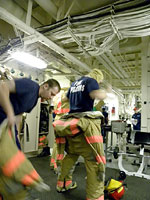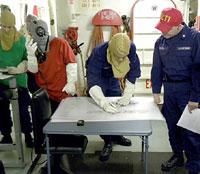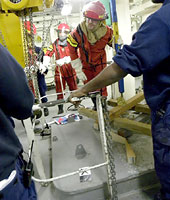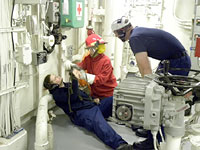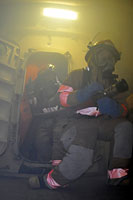

 | |||||||||||||||||
|
|
Journals 2009/2010Jonathan Pazol
September 11, 2009 For those of us on the mid-watch from midnight to 8 am, Fridays can be tough. I didn't get to sleep until after 9 am, the daily siren goes off at noon, and then the crew conducts their Safety Drills at 1 pm. These drills involve lots of piped announcements and various sirens and can last until 2:30 pm - not very conducive for sleep; however, they are much more important for ensuring the safety of everyone on the ship. Every week the Healy crew engages in a different kind of drill, whether for fire, flooding, medical emergencies, helicopter crash, man-overboard, or some combination of them all. When the sirens go off, crewmembers drop what they are doing and report to their various stations. Their goal is to be mustered and dressed in less than 4 minutes. Gear lockers are spread out throughout the ship.
Once the emergency has been called and the crew is dressed, actual simulations take place. Various people are in charge of each group, and the color of their clothing signifies their specific jobs. They often use large laminated safety diagrams to mark the location of the problem and then communicate with their teams (and others) over walkie-talkies. A Damage Control Team Trainer (DCTT) supervises and makes suggestions for better performance.
This particular drill involved flooding in one of the lower engine rooms, a medical injury that would result in an amputation, and a fire caused by the flooding. The coordination among the various teams was impressive. For the flooding, one of the hatches had to be shored up. A frame and brace were placed over it to prevent water from entering a second compartment.
The medical emergency consisted of a crewmember with an injured arm. Medical personnel stabilized the person and then carried him to the operating table in the mess (it doubles as one of the tables we eat on), where procedures for a simulated amputation were performed.
After the flood, a fire broke out, so the fire teams were deployed to contain it. Hoses had to be connected and run down through the hatch to the lower deck. In case of an actual fire, CO2 (carbon dioxide) could be released into the area to contain it.
After 9/11, the Coast Guard was put under the jurisdiction of the Office of Homeland Security. Although their main function on this cruise is to support the scientific research, the crew members still need to be trained to ensure the safety of anyone in peril at sea. Many members of the Healy crew have performed search and rescue along the coasts, have had to control fires on various ships, and have saved numerous lives - often while risking their own. On this September 11th, it is appropriate to honor them for their bravery and commitment. |
||||||||||||||||
